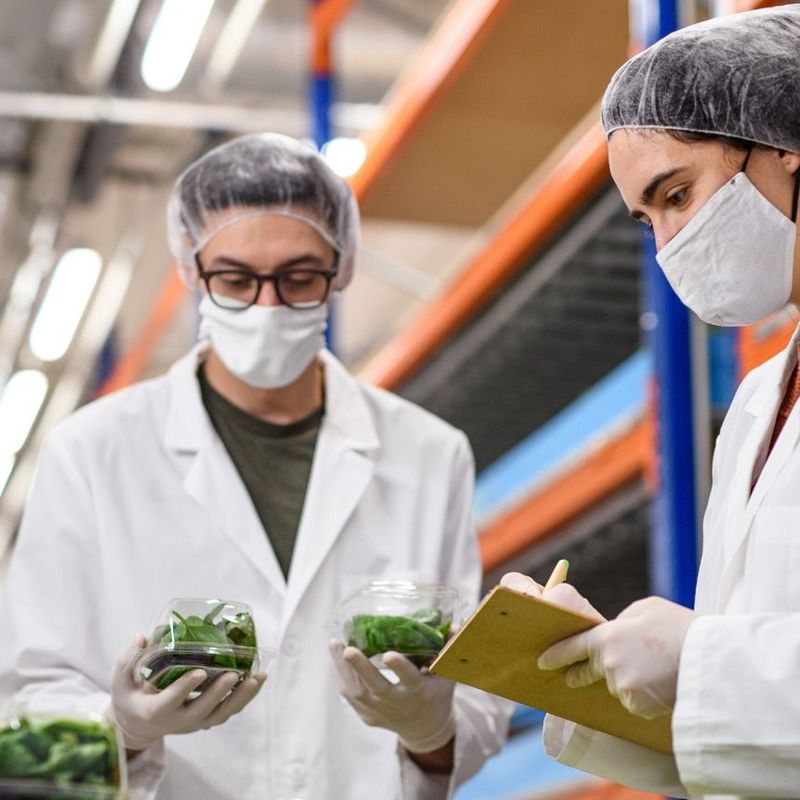27 March 2025
The EU has decreed that every company which processes food must establish and promote a food safety culture among its employees. But what is meant by food safety culture, how do you make employees aware of it, and what progress has been made in this area in recent decades? We addressed these questions with Oliver Eck, food safety expert at TÜV NORD.
Mr. Eck, what is commonly understood by the term “food safety culture”?
Oliver Eck: Having afood safety culture is about raising employees’ awareness of how fundamental the production of safe food is, and of where risks can arise in the work processes and how they can be managed. As surprising as it may sound, many employees are simply not fully aware that mistakes or negligence in production can in the worst-case scenario lead to food poisoning. And that consumers will then be at risk, alongside the company’s own business and jobs.
Where does this lack of awareness come from?
The type of training background people have has certainly has a lot to do with it: In a company that mainly employs staff with training in the food sector, the food safety culture tends to be more of a given. The situation is different in large companies with many unskilled or semi-skilled employees, who often speak little or no German. The language skills and level of training of the employees therefore also need to be considered when it comes to establishing a food safety culture: A notice written in officialese and peppered with technical terms and abbreviations is unlikely to lead to the desired result except in the rarest of cases.
With its amendment to the Hygiene Regulation, the EU has made the food safety culture mandatory. What does this mean for companies?
According to the EU regulation, every company must establish a food safety culture among its employees and review it for effectiveness. The type and size of the company must be considered in its implementation. In other words, for an international group with thousands of employees, the audit has more comprehensive requirements than would be the case for a street-corner kebab shop. The regulation also stipulates that the food safety culture is a management task, meaning that management can’t delegate responsibility for it further down the staff hierarchy.
How effectively it has been established in a company is then to be reviewed in audits, which will include surveying the workforce, as the EU has explained in a notice to the regulation. The private food safety standards which the food safety culture has previously anchored in its catalogues of requirements, as witnessed by the legislature, go one step further here. They demand, for example, specific plans for implementation: The company concerned must explain what exactly it is planning for the next year, how those plans are to be implemented and how success will be measured. These plans are to be reviewed at least once a year and may need to be adjusted.
© Adobe StockEverything clean with lemons? There are microbiological criteria that must be met for every area of food processing.
© Adobe StockIn the area of food safety, laws and regulations have been repeatedly tightened in the past. Unannounced audits are mandatory.
How can employees be made aware of food safety?
They might be sent on training courses on special aspects of food hygiene or shown a tutorial video in the canteen, where all employees spend time during the day anyway. Also useful are measures in employees’ immediate work environment, such as so-called “foreign body hunting” days, on which staff members walk through the production area to identify foreign body contamination risks. For instance, are there loose screws or ripped plastic surfaces from which splinters might get into the product? No food safety culture will work without an active culture of mistakes: If, for example, workers conceal the fact that a product has fallen on the floor because they’re afraid to report it, this can be harmful to both consumers and the company itself. Workers therefore need to be reassured in no uncertain terms that they won’t have to fear sanctions if they report mishaps, mistakes or problems.
How can you check whether a food safety culture is actually being practised?
When I visit a company in my role as auditor, I can often tell by the tone of the conversation. If supervisors constantly interrupt their employees or even tell them not to speak, then you can be confident this isn’t the case. There are also hard facts, of course, such as the complaint rate and the number of complaints, which provide information about the health or otherwise of the food safety culture in any given company.
What progress has been made in food safety in recent decades?
Laws and regulations have been tightened and refined over the years. In that time, microbiological criteria which the foods must satisfy in any given case have been defined for every area. And as the analytical methods become more and more accurate, we can monitor this ever more effectively. This applies not only to potentially hazardous substances, such as pesticide residues in cereals or spices, but also to food fraud. The horse meat scandal of 2013, for example, probably wouldn’t have been uncovered at all without modern analytical methods. And private food standards in particular have continued to tighten and expand their requirements, making unannounced audits mandatory, for example.
How does an unannounced audit work?
In the event of an unannounced audit, the company must grant us access to the production area within 30 minutes. Once there, we usually start with a quick run-through, beginning with the high-risk areas where hygiene and cleanliness are particularly important. For example, in the case of a mashed potato manufacturer, this would be the station where the mashed potatoes are filled with milk; for a producer of cured meats, it would be the area where the meat is sliced. Then the actual audit starts, in which we go through the entire process flow, from goods receipt to warehousing, production and final inspection through to despatch. We also take two or three reserve samples of the manufactured products for a traceability test. And we ask the machine operatives questions like what they do if they notice something odd in production, or how their supervisors react when they report problems or a mistake happens. Based on the answers, we get a clear picture of whether the food safety culture plan the company has set for itself is working or if there’s a need for improvement.
Oliver Eck is Director of the international Business Entity Food and a member of the board of management of TÜV NORD Austria. The nutritionist is also the lead auditor for the current food safety standards.






